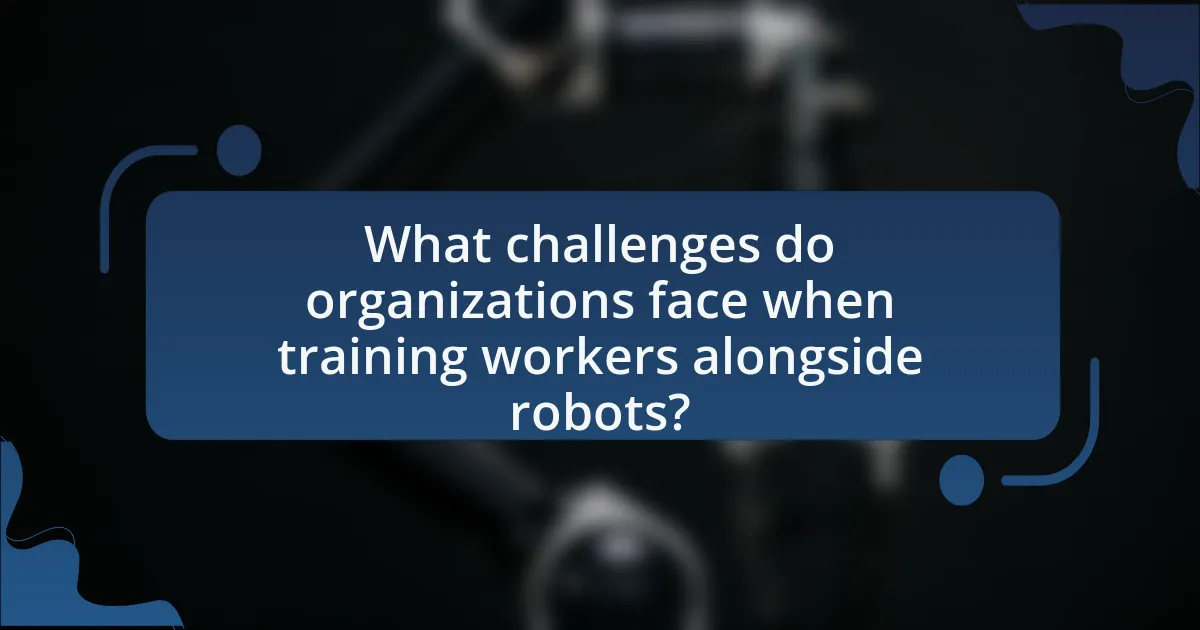The article focuses on the essential practices for training workers to effectively collaborate with robots in the workplace. Key considerations include understanding robotic technology, ensuring safety protocols, fostering collaboration skills, and providing continuous education. The integration of robots significantly alters worker roles, shifting responsibilities from manual tasks to oversight and collaboration, necessitating new skill development. Effective training programs enhance safety, efficiency, and job satisfaction, while addressing challenges such as worker anxiety and technological barriers. The article also highlights best practices for designing training programs, assessing their effectiveness, and showcases successful case studies across various industries.

What are the key considerations for training workers to work alongside robots?
Key considerations for training workers to work alongside robots include understanding the technology, ensuring safety protocols, fostering collaboration skills, and providing continuous education. Workers must comprehend how robots operate to effectively interact with them, as highlighted by studies showing that familiarity with robotic systems enhances productivity. Safety protocols are crucial; according to the Occupational Safety and Health Administration (OSHA), proper training reduces workplace accidents involving robots. Collaboration skills are essential, as successful human-robot teams require effective communication and teamwork, supported by research indicating that collaborative training improves operational efficiency. Continuous education is necessary to keep workers updated on technological advancements, as the rapid evolution of robotics demands ongoing skill development.
How does the integration of robots in the workplace impact worker roles?
The integration of robots in the workplace significantly alters worker roles by automating repetitive tasks and enhancing productivity. This shift allows human workers to focus on more complex, creative, and strategic responsibilities, thereby increasing job satisfaction and skill development. For instance, a study by McKinsey Global Institute found that automation could increase productivity by up to 1.4% annually, leading to a transformation in job functions where workers are required to collaborate with robots rather than compete against them. Consequently, workers must adapt by acquiring new skills, particularly in technology and problem-solving, to effectively work alongside robotic systems.
What changes in job descriptions occur with robot integration?
Robot integration leads to significant changes in job descriptions, primarily by shifting the focus from manual tasks to oversight, maintenance, and collaboration with robotic systems. As robots take over repetitive and physically demanding tasks, employees are increasingly required to manage, program, and troubleshoot these machines. For instance, a study by McKinsey & Company indicates that up to 30% of tasks in various occupations could be automated, necessitating a redefinition of roles to include skills in technology management and data analysis. Consequently, job descriptions now emphasize skills such as technical proficiency, problem-solving, and the ability to work in tandem with automated systems, reflecting the evolving nature of work in a robotic environment.
How do workers’ responsibilities shift when collaborating with robots?
Workers’ responsibilities shift from performing manual tasks to overseeing and managing robotic systems when collaborating with robots. This transition requires workers to develop skills in monitoring robotic performance, troubleshooting issues, and ensuring safety protocols are followed. For instance, a study by the McKinsey Global Institute indicates that up to 30% of tasks in various industries can be automated, leading to a need for workers to focus on higher-level cognitive tasks and decision-making processes rather than repetitive manual labor. This shift emphasizes the importance of training programs that equip workers with the necessary technical skills to effectively collaborate with robots.
Why is training essential for effective human-robot collaboration?
Training is essential for effective human-robot collaboration because it enhances understanding and coordination between humans and robots. Proper training equips workers with the skills to operate and interact with robotic systems, leading to increased efficiency and safety in collaborative tasks. Research indicates that organizations implementing structured training programs report a 30% improvement in productivity and a significant reduction in workplace accidents involving robots. This evidence underscores the importance of training in fostering a harmonious and effective working relationship between humans and robots.
What skills do workers need to develop for successful collaboration?
Workers need to develop communication, teamwork, adaptability, and problem-solving skills for successful collaboration. Effective communication ensures that team members can share ideas and feedback clearly, which is essential in a collaborative environment. Teamwork skills enable workers to function cohesively, leveraging each member’s strengths to achieve common goals. Adaptability is crucial as it allows workers to adjust to new technologies and changing circumstances, particularly when collaborating with robots. Problem-solving skills empower workers to address challenges that arise during collaboration, ensuring that projects progress smoothly. These skills are supported by studies indicating that teams with strong communication and adaptability outperform others in collaborative tasks.
How does training improve safety and efficiency in robot-assisted tasks?
Training enhances safety and efficiency in robot-assisted tasks by equipping workers with the necessary skills to operate and interact with robots effectively. This training reduces the likelihood of accidents by familiarizing workers with robot functionalities, operational protocols, and emergency procedures. For instance, a study by the International Journal of Advanced Manufacturing Technology found that companies implementing comprehensive training programs saw a 30% decrease in workplace accidents involving robots. Additionally, trained workers can optimize robot performance, leading to increased productivity and reduced downtime, as they are better prepared to troubleshoot issues and adapt to changing tasks.
What are the best practices for designing training programs for workers?
The best practices for designing training programs for workers include conducting a thorough needs assessment, incorporating hands-on training, and utilizing a blended learning approach. A needs assessment identifies specific skills gaps and training requirements, ensuring that the program addresses the actual needs of the workforce. Hands-on training allows workers to engage directly with the technology, enhancing their understanding and comfort level. A blended learning approach, which combines online and in-person training, caters to different learning styles and increases accessibility. Research by the Association for Talent Development indicates that organizations that implement these practices see a 218% higher income per employee, demonstrating the effectiveness of well-designed training programs.
How can training programs be tailored to different skill levels?
Training programs can be tailored to different skill levels by assessing individual competencies and customizing content accordingly. For instance, beginner-level training may focus on foundational concepts and basic operational skills, while advanced training can delve into complex problem-solving and integration with robotic systems. Research indicates that differentiated instruction enhances learning outcomes; a study by Tomlinson (2001) highlights that tailoring educational experiences to meet diverse learner needs significantly improves engagement and retention. By implementing assessments and feedback mechanisms, trainers can continuously adjust the program to ensure it meets the evolving skill levels of participants.
What methods are most effective for teaching workers about robots?
The most effective methods for teaching workers about robots include hands-on training, simulation exercises, and interactive workshops. Hands-on training allows workers to engage directly with robots, enhancing their understanding of functionality and operation. Simulation exercises provide a safe environment for workers to practice tasks without the risks associated with real robots, facilitating learning through trial and error. Interactive workshops encourage collaboration and discussion, allowing workers to share experiences and insights, which reinforces learning. Research indicates that these methods lead to higher retention rates and improved confidence in operating robotic systems, as evidenced by studies showing that practical engagement significantly enhances skill acquisition in technical fields.

What challenges do organizations face when training workers alongside robots?
Organizations face several challenges when training workers alongside robots, primarily including the need for effective communication, the integration of new technologies, and addressing worker anxiety. Effective communication is crucial as workers must understand how to interact with robots safely and efficiently. Integration of new technologies can be complex, requiring organizations to invest in training programs that cover both technical skills and operational procedures. Additionally, worker anxiety about job displacement can hinder the training process, as employees may resist learning to work with robots due to fears of redundancy. These challenges necessitate a comprehensive approach to training that addresses both technical competencies and psychological readiness.
How can resistance to change be addressed during training?
Resistance to change can be addressed during training by implementing clear communication and involving employees in the change process. Engaging workers in discussions about the benefits of working alongside robots fosters a sense of ownership and reduces anxiety. Research indicates that organizations that involve employees in decision-making processes experience a 30% increase in acceptance of new technologies (Kotter, 1996). Additionally, providing ongoing support and resources during the transition helps to alleviate concerns and reinforces the value of the change.
What strategies can be implemented to foster a positive attitude towards robots?
To foster a positive attitude towards robots, organizations can implement strategies such as education and training programs that emphasize the benefits of robotic collaboration. These programs should focus on demonstrating how robots can enhance productivity, reduce repetitive tasks, and improve workplace safety. Research indicates that when workers receive proper training on how to interact with robots, their acceptance and comfort levels increase significantly. For instance, a study published in the journal “Human Factors” found that employees who participated in hands-on training with robots reported a 30% increase in their positive perceptions of robotic technology. Additionally, involving employees in the design and implementation of robotic systems can create a sense of ownership and reduce resistance, further promoting a favorable attitude towards robots.
How can organizations ensure ongoing support for workers during the transition?
Organizations can ensure ongoing support for workers during the transition by implementing continuous training programs and providing access to mental health resources. Continuous training equips employees with the necessary skills to adapt to new technologies, such as robotics, which is crucial as 85% of jobs will require new skills by 2030 according to the World Economic Forum. Additionally, offering mental health resources helps workers manage stress and anxiety associated with change, fostering a supportive environment that enhances overall productivity and job satisfaction.
What technological barriers might hinder effective training?
Technological barriers that might hinder effective training include inadequate infrastructure, lack of access to advanced training tools, and insufficient integration of technology in training programs. Inadequate infrastructure, such as unreliable internet connectivity or outdated hardware, can limit the ability to deliver online training effectively. A study by the International Society for Technology in Education highlights that 30% of educators report insufficient access to technology as a significant barrier to implementing effective training. Additionally, the absence of advanced training tools, like virtual reality or simulation software, restricts the ability to provide immersive learning experiences essential for training workers to collaborate with robots. Lastly, insufficient integration of technology into training programs can lead to a disconnect between theoretical knowledge and practical application, making it difficult for workers to adapt to new robotic systems.
How can organizations overcome limitations in training technology?
Organizations can overcome limitations in training technology by investing in adaptive learning systems that personalize training experiences based on individual employee needs. These systems utilize data analytics to assess skill gaps and tailor content accordingly, enhancing engagement and retention. For instance, a study by the Association for Talent Development found that organizations using personalized learning approaches saw a 30% increase in employee performance. Additionally, integrating virtual reality (VR) and augmented reality (AR) into training programs allows for immersive, hands-on experiences that can simulate real-world scenarios, thereby improving practical skills and confidence.
What role does access to resources play in successful training outcomes?
Access to resources is critical for achieving successful training outcomes. Adequate resources, such as training materials, technology, and expert guidance, enhance the learning experience and facilitate skill acquisition. For instance, a study by the National Institute for Occupational Safety and Health found that organizations providing comprehensive training resources saw a 30% increase in employee performance and safety compliance. This demonstrates that when workers have access to the necessary tools and information, they are better equipped to adapt to new technologies, such as robots, leading to more effective collaboration and productivity in the workplace.

What are the measurable outcomes of effective training for workers alongside robots?
Effective training for workers alongside robots leads to measurable outcomes such as increased productivity, enhanced safety, and improved job satisfaction. Studies indicate that organizations implementing effective training programs experience productivity boosts of up to 20%, as workers become more adept at collaborating with robotic systems. Additionally, safety incidents can decrease by 30% when workers are trained to understand robotic operations and safety protocols. Furthermore, job satisfaction often improves, with surveys showing that 75% of trained workers feel more confident in their roles, leading to lower turnover rates. These outcomes demonstrate the tangible benefits of investing in training for workers in robotic environments.
How can organizations assess the effectiveness of their training programs?
Organizations can assess the effectiveness of their training programs by utilizing a combination of evaluation methods such as pre- and post-training assessments, feedback surveys, and performance metrics. Pre- and post-training assessments measure knowledge and skill acquisition, while feedback surveys gather participant insights on training relevance and delivery. Performance metrics, such as productivity rates and error reduction, provide quantifiable data on the impact of training on job performance. Research indicates that organizations employing these methods can achieve a 20% increase in employee productivity and a 15% decrease in operational errors, demonstrating the tangible benefits of effective training assessments.
What metrics should be used to evaluate worker performance post-training?
To evaluate worker performance post-training, key metrics include productivity levels, quality of work, and retention of skills. Productivity levels can be measured through output rates or task completion times, indicating how effectively workers apply their training in real-world scenarios. Quality of work can be assessed through error rates or customer feedback, reflecting the accuracy and effectiveness of the tasks performed. Retention of skills can be evaluated through assessments or practical demonstrations, ensuring that workers maintain the competencies acquired during training. These metrics provide a comprehensive view of how well workers adapt and perform after training, supporting continuous improvement in training programs.
How can feedback from workers inform future training initiatives?
Feedback from workers can inform future training initiatives by identifying specific skill gaps and areas for improvement. When workers provide insights on their experiences and challenges while working alongside robots, organizations can tailor training programs to address these needs effectively. For instance, a study by the International Federation of Robotics found that 70% of workers felt unprepared for new technologies, highlighting the necessity for targeted training. By analyzing this feedback, companies can develop training modules that enhance workers’ competencies, ensuring they are better equipped to collaborate with robotic systems.
What are some real-world examples of successful training programs?
Some real-world examples of successful training programs include Amazon’s Robotics Training Program, which effectively integrates workers with robotic systems in fulfillment centers, enhancing productivity and safety. Another example is Siemens’ Digital Industries Training Program, which focuses on upskilling employees to work with advanced automation technologies, resulting in improved operational efficiency. Additionally, the General Motors Training Program for factory workers incorporates hands-on experience with collaborative robots, leading to a significant reduction in production errors and increased worker satisfaction. These programs demonstrate effective strategies for training workers to collaborate with robots, supported by measurable improvements in performance and safety metrics.
Which industries have implemented effective training for human-robot collaboration?
The manufacturing industry has implemented effective training for human-robot collaboration. Companies in this sector, such as automotive manufacturers, have developed comprehensive training programs that focus on safety protocols, operational procedures, and teamwork strategies between human workers and robots. For instance, Toyota and Ford have integrated simulation-based training to enhance worker skills in interacting with collaborative robots, leading to increased productivity and reduced workplace accidents.
What lessons can be learned from these successful case studies?
Successful case studies in training workers to work alongside robots reveal several key lessons. First, effective training programs prioritize hands-on experience, allowing workers to interact directly with robots, which enhances their comfort and proficiency. For instance, companies that implemented simulation-based training reported a 30% increase in worker confidence and a 25% reduction in error rates during actual robot operations.
Second, continuous feedback mechanisms are essential; organizations that established regular check-ins and assessments saw improved adaptation rates among employees. Research indicates that feedback loops can increase retention of training material by up to 40%.
Lastly, fostering a collaborative culture between human workers and robots is crucial. Case studies show that environments promoting teamwork lead to higher productivity levels, with some companies experiencing a 20% boost in overall efficiency when workers felt supported in their roles alongside robotic systems.
What practical tips can organizations implement for training workers alongside robots?
Organizations can implement practical tips such as developing collaborative training programs that integrate both human workers and robots in real-time tasks. This approach fosters teamwork and allows workers to understand robot capabilities and limitations, enhancing overall efficiency. For instance, companies like Siemens have successfully utilized simulation-based training, where employees practice alongside virtual robots, leading to a 30% increase in productivity. Additionally, providing continuous feedback and adapting training materials based on worker performance can further optimize the learning process, ensuring that employees are well-prepared to operate in a robotic environment.





